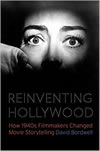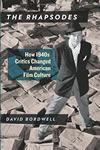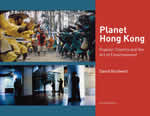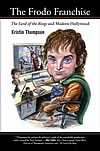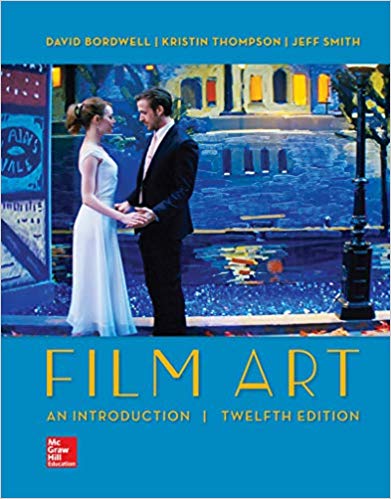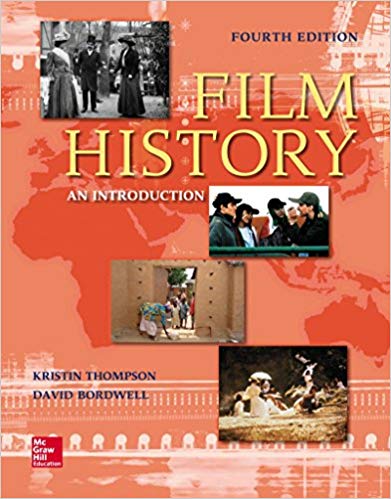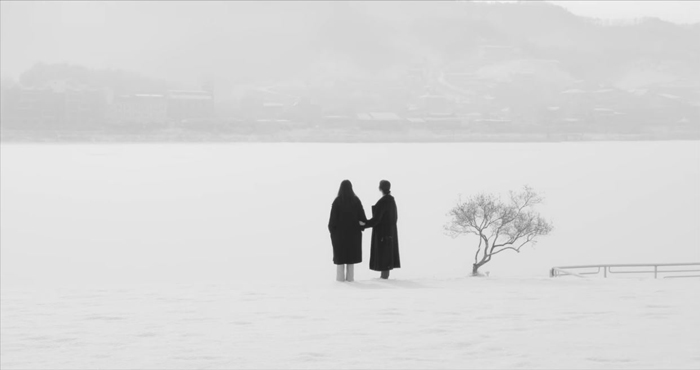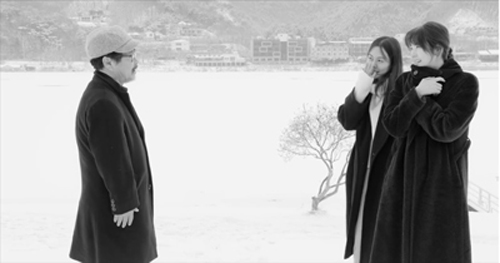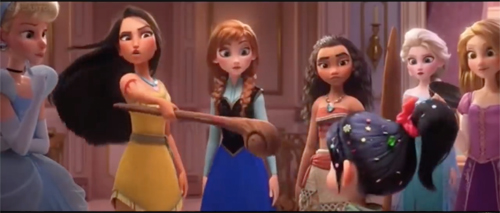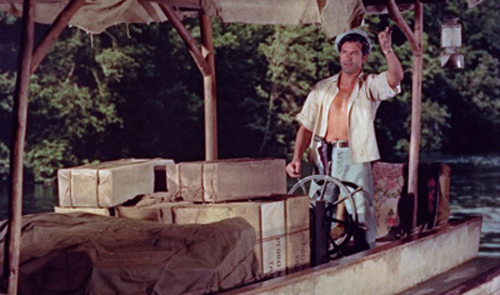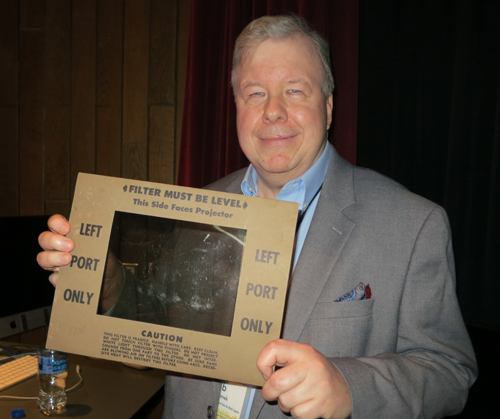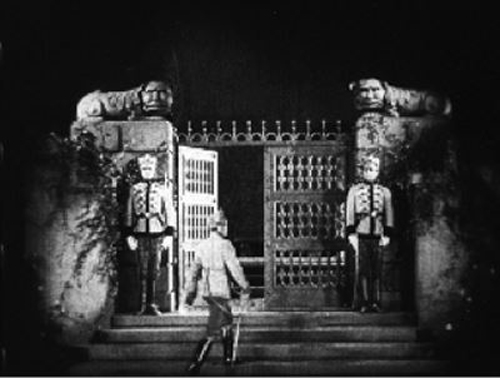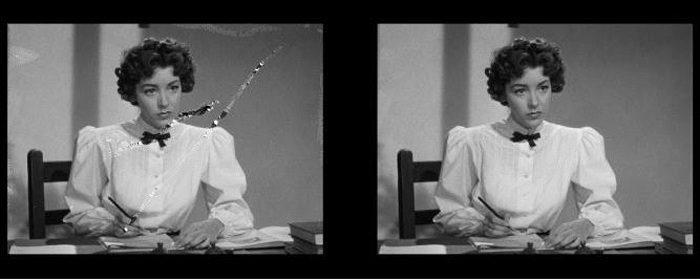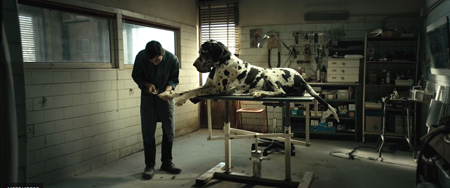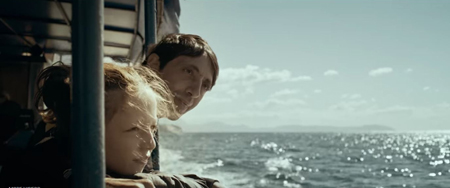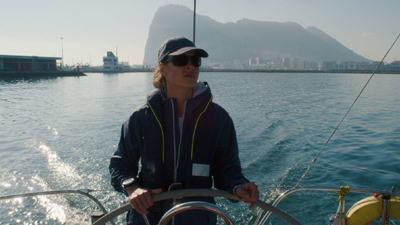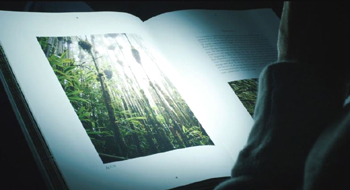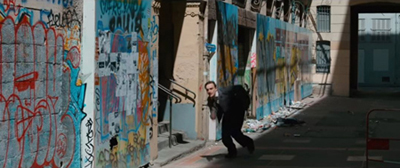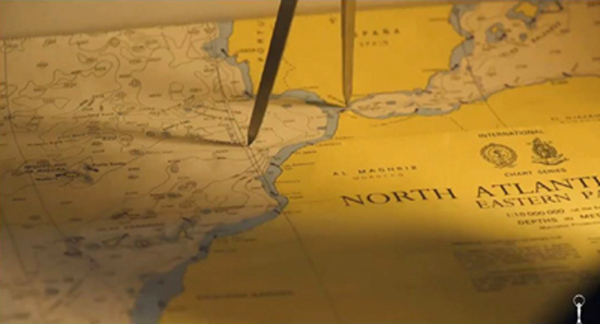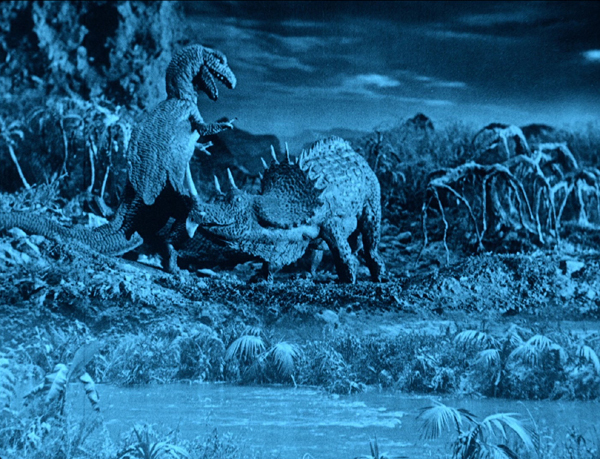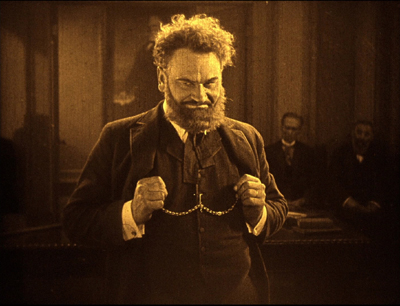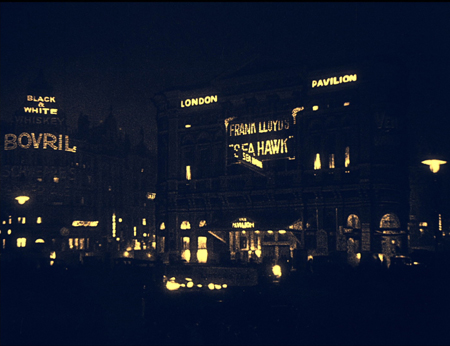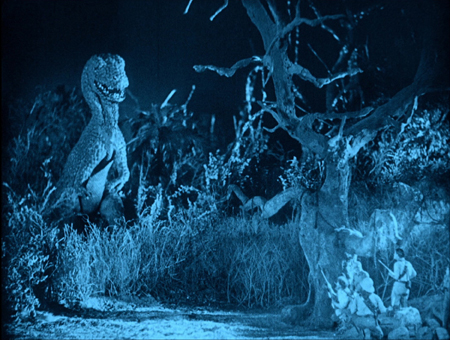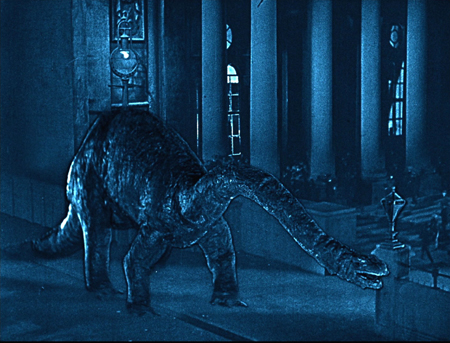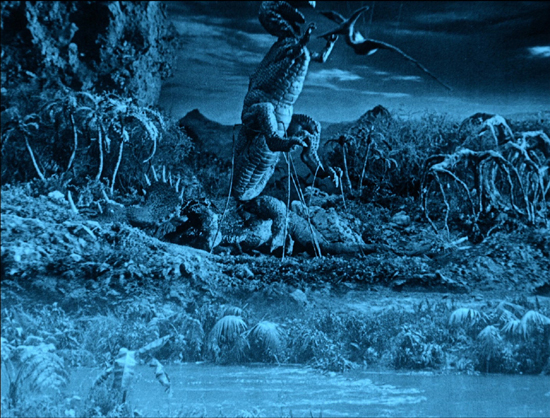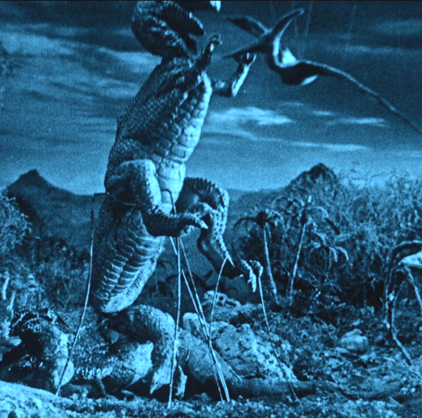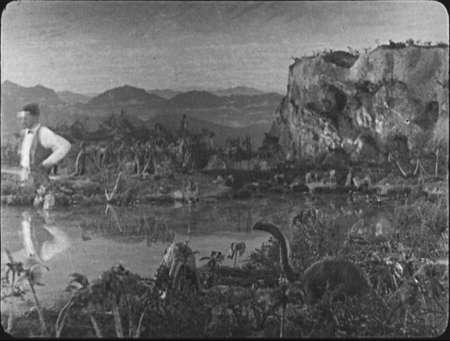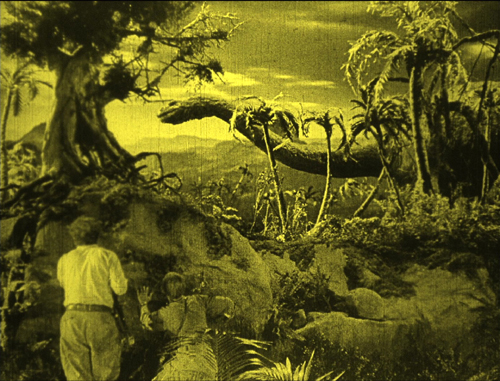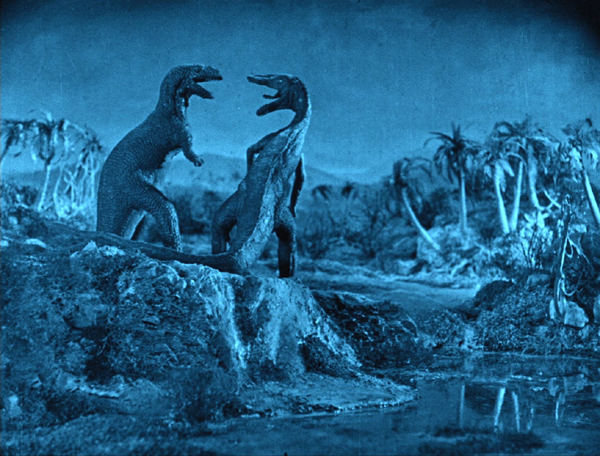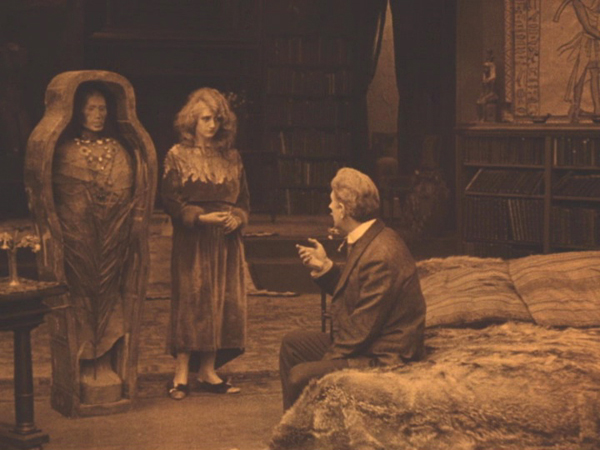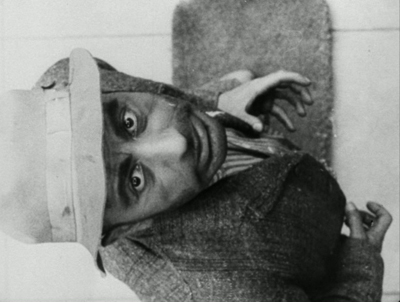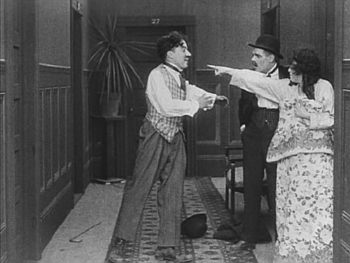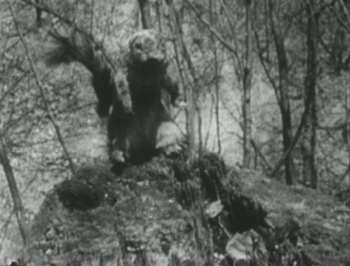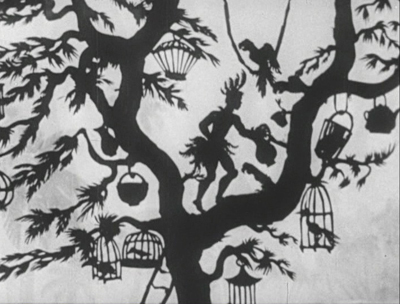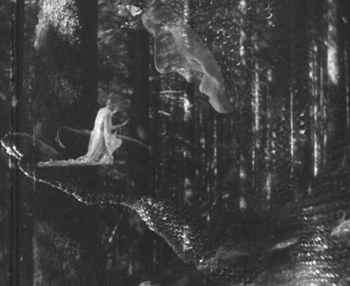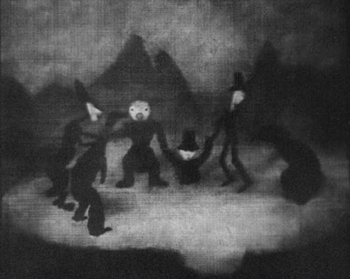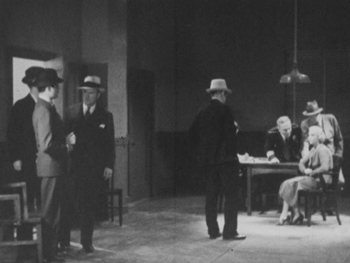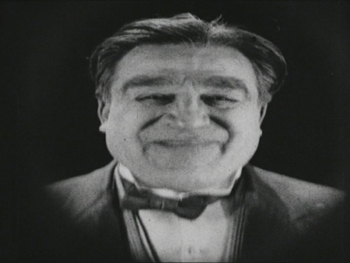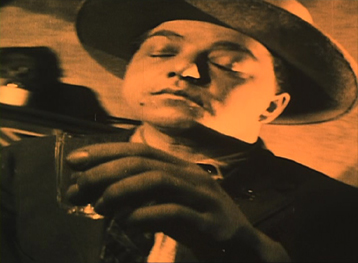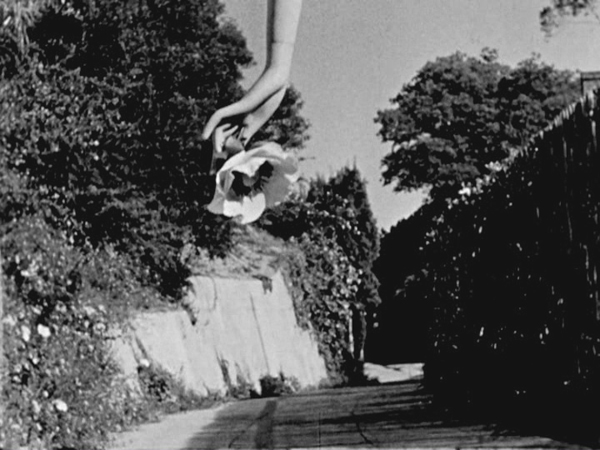Archive for the 'Animation' Category
Reporting from the Wisconsin Film Festival 2019
Hotel by the River (2018).
Kristin here:
The Wisconsin Film Festival is all too rapidly approaching its end, so it’s time for a summary of some of the highlights so far.
New films from around the world
We have not quite managed to catch up with all the recent films by Korean director Hong Sang-soo, but we took a step closer with Hotel by the River. It’s an impressive film, in part by virtue of its setting. The Hotel Heimat stands beside a river which is covered in ice and snow. Even the further shore with its mountains, is reduced to shades of light gray in the misty, cold light. All of this is enhanced by the black-and-white cinematography that creates a background against which the characters and the small trees create simple, austere compositions.
The story involves an aging poet who somehow senses that he is going to die soon and settles in at the hotel to wait for death. His two sons, one a well-known art-film director with a creative block and the other secretly divorced, come to visit. A young woman who has recently broken up with her married lover is visited by a sympathetic character who may be her sister, cousin, or friend. They encounter the poet by the river, and he compliments them effusively for adding to the beauty of the scene. Conversations about life ensue. The women take naps, the men bicker. Sang-soo’s typical parallels and repetitions unfold. It’s a lovely film.
Yomeddine, an Egyptian film, created something of a stir last year when it was shown in competition at Cannes. It was a surprising choice, given that it is writer-director A. B. Shawky’s first feature.
It’s also a modest, low-budget film, and like so many such films made in countries with limited production, it’s a road movie. No need to build sets or use complex lighting. The two central characters are Beshay, dropped off as a small child at a leper colony by his father, and Obama, a young orphan who knows nothing of his birth parents. Coincidentally, they both come from Qena, a city north of Luxor on the great Qena Bend of the Nile. Longing for links to their origins, the two set out there. At first they ride in the donkey cart that Beshay uses in his work as a garbage-picker, but later, when the donkey dies, they travel on foot and occasionally by train, riding without benefit of tickets.
There’s no indication where the orphanage and leper colony are and thus how long a trek the two face. I’m pretty familiar with the Nile, but they follow the large canals and train tracks that run parallel to the river on both banks. The villages along their route look pretty much alike. Shortly into the trip, however, Shawky suddenly confronts us with the Meidum pyramid (above), which acts as a handy landmark to reveal that the pair have a long way to go. It’s Shawky’s only display of an ancient site. Beshay and Obama have no idea what it is, but they explore it and spend the night in its small chapel.
Yomeddine is a likeable film blending humor, pathos, and a little suspense as it follows the pair on their quest. It’s also a plea for tolerance. Beshay’s deformities scare off those who wrongly think that leprosy is contagious (with treatment it is not), and Obama is denigrated by his classmates as “the Nubian,” for his relatively dark skin. Their sometimes prickly odd-couple friendship is a demonstration of how people of various backgrounds, including those on the margins of society, can get along. That, I suspect, is what led Cannes programmers to include it in the competition.
Overall it’s a well-made, entertaining film, perhaps an indication that we shall see more from Beshay on the festival circuit in the future.
[April 19: Yomeddine won the Audience Favorite Narrative Feature at the Wisconsin Film Festival.]
Ralph and Venellope Back in 3D
Phil Johnston with Ben Reiser, Senior Programmer, Wisconsin Film Festival.
UW–Madison grad Phil Johnston was a key participant in the festival. Not only did he program one of his favorites, Ozu’s Good Morning (1959), but he also visited a class and ran a public event around Wreck-It Ralph 2: Ralph Breaks the Internet. Phil was a writer on both entries and co-director on the second, while also providing screenplays for Zootopia (2016) and Cedar Rapids (2011). We’re very proud of him, and we were happy to welcome him back home.
I love both the Wreck-It Ralph films, but I don’t like to go to hit movies early in their runs. We usually wait a few weeks till the crowds die down. As I recently pointed out, though, that means risking no longer having the option of seeing a 3D film in that format. So it happened with both Ralph Breaks the Internet and Spider-Man: Into the Spider-Verse.
Fortunately for us, the UW Cinematheque added permanent 3D capacity to its projection options, so Ralph 2 was shown in that format. The 3D much enhances the sense of being surrounded by the myriad “websites” in the scenes showing general views of “the internet,” as well as by the vehicles and netizens that flash past in their travels.
Both Ralph films display a non-stop inventiveness, and I agree with Peter Debruge’s comment that Wreck-It-Ralph “ranks among the studio’s very best toons.” The sequel is, if anything, even better. The scene in which Venellope von Schweetz confronts the full panoply of Disney princesses and tries to prove herself one of them became a classic before the film was even released.
The notion of Venellope moving from the sickly sweet “Sugar Rush” arcade game to the wildly dangerous online “Slaughter Race” (see bottom) is a great concept to begin with, and her rendition of her “Disney princess” song, “A Place Called Slaughter Race” is hilarious. The film was robbed, in my opinion, when her song didn’t get nominated for a Oscar.
The film has jokes to burn, as in the clever puns on the signs that flash in the internet and game scenes. I look forward to being able to freeze-frame the images to catch the many I missed. Unfortunately the Blu-ray release will not be in 3D. Disney has been phasing out releasing its 3D films in that format ever since Frozen, but you could for a time order such discs from abroad. (Other studios are following suit, and our 3D copy of Into the Spider-Verse is wending its way from Italy as I type.) I am told that the only 3D Ralph will be the Japanese version, at something like $80. Fortunately, it looks great in 2D as well, but I’m glad to have seen it on the big screen in 3D once.
So old they’re new again
Jivaro (1954).
Recent restorations have become a increasingly important component of our festival’s wide variety of offerings. Selections from the previous year’s Il Cinema Ritrovato festival in Bologna are now regularly programmed, and we had visiting curators presenting their new projects. (For a brief rundown of the Bologna offerings this year, see here.)
Another film taking advantage of the Cinematheque’s new 3D capacity was Jivaro, a jungle-adventure film of the type more popular in the 1950s and 1960s than it is now. Having seen a such films when growing up, I can say that Jivaro is better than many of its type.
It was made late in the brief early 1950s vogue for 3D, so late in fact that the studio decided to release it only in 2D. One attraction of its screening at the WFF was the fact that it was screening publicly for the first time ever in its intended format. Bob Furmanek, 3D devotee and expert, introduced the film and took questions afterward; he has been a driving force in the restoration of this and many other 3D films. (His immensely valuable site is here.) Below Bob shows one of the polarizing filters used in projection booths.
The film was highly enjoyable, partly for the 3D (shrunken heads thrust into the lens and spears coming at us!) and partly for the comfortable familiarity of its genre tropes. There’s the genial South American trader who has gained the respect of the locals, the seemingly deluded adventurer with a map to a lost treasure who turns out to be right, the gorgeous woman who shows up dressed in tight blouse, skirt, and high heels, the beautiful local girl in hopeless love with a white man, and so on. (The beautiful girl was an early role for Rita Moreno, who labored as an all-purpose-ethnic bit player for years before West Side Story made her a star.) Leads Fernando Lamas and Rhonda Fleming supply beefcake and cheesecake, respectively, at regular intervals. Lamas (as you can see above) barely buttoned his shirt across the whole film. It’s hot in jungles.
For those with 3D TVs, Jivaro is already out on Blu-ray.
The Museum of Modern Art has followed up its restoration of Ernst Lubitsch’s Rosita (1923) with one of Forbidden Paradise (1924). Both were shown at this year’s festival. We saw Rosita at the 2017 Venice International Film Festival and wrote about it then. In preparing my book Herr Lubitsch Goes to Hollywood (2005; available free as a PDF here), I saw an incomplete copy of one preserved in the Czech film archive–a key element in constructing this new version. Naturally I was eager to see the new scenes and much-improved visual quality of the MOMA restoration. Archivist Katie Trainor was present to explain the process, which yielded a version that is about 90% the length of the original.
Of all Lubitsch’s Hollywood films, this is the one that most looks back to his German features of the late 1910s and early 1920s. For one thing, his frequent star of that period, Pola Negri, was by now in Hollywood and worked here with him again here, their sole Hollywood collaboration. She stars in a highly fanciful tale of Catherine the Great, and the quasi-Expressionistic sets present an appropriate version of historical style. The set in the frame above (taken from a 35mm print, not the restored version) is my favorite, with its lugubrious creatures crouched atop the wall. Grotesque sphinxes? (The designer might have been thinking of the the two beautiful granite sphinxes of Amenhotep III that sit to this day by the Neva River in front of the Academy of Arts, though they were brought to Russia decades after Catherine’s reign.) Or just elaborate gargoyles?
The plot centers around a brief affair between a young officer (Rod La Rocque) and the licentious Catherine. A brief attempt at revolution flares up. All this is deftly dealt with by the Lord Chamberlain, played by Adolf Menjou, hamming it up with eye-rolls and knowing chuckles.
It’s not first-rate Lubitsch, largely lacking the lightness that one associates with the director, and which he had already achieved in his second Hollywood film, The Marriage Circle (1924). But it’s a pleasant entertainment, and the set and costume designs are visually engaging–especially in this excellent new restoration.
David watched None Shall Escape (1944) for his book on 1940s Hollywood, but I was unfamiliar with it until its restored version was shown here as one of the Il Cinema Ritrovato contributions. The film was originally made by Columbia and was presented at our fest in a 4K restoration from Sony Pictures Entertainment, the parent company of Columbia. Rita Belda, SPE’s Vice President of asset management, was here to explain the complicated process. She summarizes it here as well.
The film had been carefully preserved, probably because of its historical importance as a unique fictional depiction of Nazi atrocities. The original negative and three preservation positives survived. These had the usual scratches and tears, as evidenced in the first comparison image above. A significant challenge, however, was that the prints had all been lacquered in a misguided attempt to preserve them. The result was staining throughout, evident in both comparison images. Digital removal allowed for a stunningly clear image throughout the finished version.
None Shall Escape is notable as the only Hollywood film made during the war to depict major aspects of the Holocaust. It begins with a frame story set in the future. This postwar trial of Nazi criminals remarkably prefigures the Nuremberg trials. Testimony is given against a single officer, who stands in for all the accused officers and collaborators. Wilhelm Grimm begins as a schoolteacher in a small Polish city but proves so devoted to the Nazi cause that he rapidly rises through the ranks. After the city is seized during the German invasion, Grimm comes to rule the city. At the trial, townsfolk who had resisted and suffered under his domination testify, and their stories unfold as a series of lengthy flashbacks.
The film is an effective and moving drama, not least because it demonstrates the explicitness with which it was possible to depict Naziism in this period. It shows, as Hitler’s Children (1943) did, the insidious indoctrination of young people by the Nazi party. But no other film depicted the rounding up of Jews and their dispatch to concentrations camps–named as such.
Director André De Toth, though not a top auteur, again proves the value of sheer skill and artistry in filmmaking, a value that David recently discussed in relation to Michael Curtiz. None Shall Escape is an impressive example of the power of the classical Hollywood system–and a beautiful film, as one might expect from cinematographer Lee Garmes. Marsha Hunt gives a moving performance as Marja, another schoolteacher who fearlessly persists in opposing Grimm and his oppression of the townspeople; it is a pity that she never achieved the stardom that she merited.
Perhaps most notably, De Toth stages a powerful scene in which Jews rebel against being packed into trains and are ruthlessly mowed down by their captors. It must have given many Americans a first glimpse of what would soon be revealed by newsreels and personal testimony.
Now, back to the movies. More festival coverage to come, when we get time to write!
For more on early 3D, see David’s entry on Dial M for Murder.
Ralph Breaks the Internet (2018).
Vancouver 2018: Panorama of the Rest of the World, the sequel
Seder-Masochism (2018)
Kristin here:
The Vancouver International Film Festival is over, but we still have films to talk about. Here are four, and David and I will probably post another blog apiece. Between Venice and Vancouver, we have seen a lot of great and very good films recently. Once again, the claims of the death of cinema are robustly refuted.
Dogman (Matteo Garrone, 2018)
Garrone is best known outside Italy for his 2008 film Gomorrah. While that film was about gangs and organized crime in Naples, Dogman centers around a shifting relationship between a meek-mannered dog/boarder/groomer who has fallen in with a volatile, enormous local thug.
The title emphasizes the honest side of Marcello’s life, and we see some comic scenes of him with dogs. Soon, however, it is revealed that he sells cocaine on the side and sometimes acts as a getaway driver for thefts committed by the monstrous ex-boxer, Simoncino. Eventually he even takes the fall for a robbery and spends a year in jail in Simoncino’s place.
We’re clearly intended to side with this sad sack. After one house robbery, Simoncino’s partner reveals that he put a dog in the freezer to keep it quiet. Marcello sneaks back in and, a suspenseful and remarkable scene, attempts to revive the frost-covered animal. He also dotes on his daughter and seemingly pursues his criminal activities in order to be able to take her on “adventures,” including scuba-diving.
Despite this sympathetic side, however, Marcello never seems to consider giving up crime; he’s mainly interested in getting his fair share of Simoncino’s ill-gotten gains. Although the film is continually entertaining and suspenseful, its ending is somewhat disappointing. We are left knowing what Marcello’s probably fate will be, but we have little sense of his attitude toward what has happened.
Marcello Fonte, looking like a rather emaciated version of the comic Toto, won the Best Actor prize at the Cannes Film Festival.
Magnolia has the US rights and plans to release Dogman in 2019.
Seder-Masochism (Nina Paley, 2018)
Seder-Masochism is the only US film I’ll be writing about from Vancouver. (We tend to skip US films here, since we assume we can see them in the US.) Paley’s not part of the Hollywood establishment or even the mainstream indie scene. It’s not easy to see her wonderful animated films on the big screen, but their bright colors and imaginative graphics deserve to be shown that way.
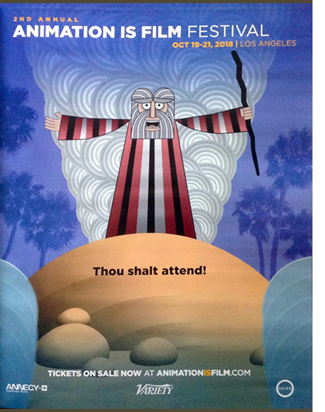 Seder-Masochism is Paley’s second feature, after Sita Sings the Blues (2008). She does all the animation herself, holed up, as she puts it, like a hermit with her computer. She also avoids the standard distribution methods for indie films, because she’s an opponent of copyright for artworks. She provides open access to her films, initially at festivals and then online. (For more on this, see my transcript of a Q&A I helped run when Sita played at Ebertfest in 2008.)
Seder-Masochism is Paley’s second feature, after Sita Sings the Blues (2008). She does all the animation herself, holed up, as she puts it, like a hermit with her computer. She also avoids the standard distribution methods for indie films, because she’s an opponent of copyright for artworks. She provides open access to her films, initially at festivals and then online. (For more on this, see my transcript of a Q&A I helped run when Sita played at Ebertfest in 2008.)
 I should say that no one should assume from the title that this film is grim and/or anti-Jewish. On the contrary, it’s a witty exploration of the Exodus myth and its historical links to the decline of early goddess worship in favor of all-powerful male gods in monothesism. The framing situation is a conversation between Paley and her father conducted shortly before his death, with Paley as a small goat and her father as God (see top).
I should say that no one should assume from the title that this film is grim and/or anti-Jewish. On the contrary, it’s a witty exploration of the Exodus myth and its historical links to the decline of early goddess worship in favor of all-powerful male gods in monothesism. The framing situation is a conversation between Paley and her father conducted shortly before his death, with Paley as a small goat and her father as God (see top).
This conversation is a mix of humor and serious points about Judaic traditions and particularly the celebration of Passover. The story of Moses and the Exodus is rendered in much the same way she treated the tale of Sita and Rama from the Hindu epic, the Ramayana–with musical numbers. Moses is introduced with “Moses Supposes,” from Singin’ in the Rain, and, inevitably, there is a “Go Down, Moses” episode. Unlike Sita, where blues songs were used throughout, the musical pieces in Seder are wide-ranging, culminating in a brilliant three-minute summary of the history of the territory which is now Israel, done to “This Land is Mine,” the song written to the theme of Otto Preminger’s Exodus. (The sequence, as well as several other excerpts from Seder are available on YouTube.)
The sequences set in ancient Egypt are generally accurate. I was amused by the fact that the animal and bird hieroglyphs in the background inscriptions moved rhythmically during the musical numbers, and the Hathor heads on the sistrums sang along. Using Hathor, the cow goddess, as the golden calf was an inspiration.
Seder-Masochism got the most enthusiastic applause I heard at the festival, partly because the filmmaker was present (in her custom Seder dress). There were Sita fans in the audience, and one Jewish lady asked how she could get a copy to show her 12-year-old daughter. Paley replied that the film will continue to play festivals and probably be available on the fim’s website for download in the spring.
In the meantime, watch for it at festivals–or let the organizers know that you want to see it on their schedule. We were happily surprised to see a full-page ad for the Los Angeles Animation Is Film Festival (October 19-21) in the current Variety (above left) and illustrated by an image derived from the film. You may find others.
Styx (Wolfgang Fischer, 2018)
I was surprised to discover that so far Austrian director Wolfgang Fischer’s Styx has not been picked up by a North American distributor. It seems like the sort of film to appeal strongly to audiences. It’s protagonist is a strong, ultra-competent woman, it has a riveting plot full of suspenseful situations, and it deals with the immigrant crisis facing Europe.
A long portion of the film contains no real dialogue. The opening sequence occurs at the scene of a traffic accident where the heroine, Rike, is established as a doctor as she heads the team treating the victim. Cut to her provisioning her yacht for a solo trip. A lovely shot of a compass “walking” its way down a map establishes her route and distant goal: Ascension Island (see bottom). Her departure reveals that her starting point is Gibraltar (above). From that point, we watch Rike expertly dealing with her vessel, enjoying the solitude of the ocean, and reading about Darwin’s activities on Ascension.
Apart from a few overheard commands during the initial emergency scene, there is no dialogue until Rike makes radio contact with a nearby commercial vessel which warns of a serious storm approaching. A tense scene of her struggle to deal with the storm at night creates the first major suspense of the film. From her arrival in an ambulance in the opening sequence, actress Susanne Wolff is present in every scene, and as an experienced sailor she was able to handle the yacht and do without a stunt double.
Rike comes through the storm without difficulty, but a leaky vessel crowded with African immigrants striving to get to Europe is visible in the distance. Ordered by a coast-guard official not to interfere, she uneasily waits for a sign of a rescue vehicle that still has not shown up after hours of waiting. One teen-aged boy manages to swim from the derelict ship, and he complicates her situation considerably. The dilemma remains: try and take the rest of the refugees on board her small yacht or wait for the promised rescue.
The remainder of the film generates unrelieved suspense as Rike debates what to do and Kingsley begs her to rescue his sister, still abroad the sinking boat. A non-actor discovered in a school in Nairobi, Gedion Oduor Weseka is convincing and touching as the desperate boy.
Nearly all of Styx was shot at sea, with Fischer’s small crew mounting their camera hanging off the sides of the boat and scrambling to keep out of sight during filming. No special effects were used for the storm and other ocean scenes. At intervals some impressive extreme long shots from overhead, presumably taken by drones, emphasize the yacht’s isolation in the vastness of the sea.
The film is riveting from beginning to end. I recommend it, though at least for North America, festival screenings are probably the main places where it can be seen. Perhaps it will eventually be available on streaming services. In some European countries, it will probably be released theatrically.
Transit (Christian Petzold, 2018)
The central premise of Transit resembles that of Casablanca. A group of émigrés are desperately awaiting the letters of transit that will allow them to flee fascist Europe for North America. In this case they’re in Marseille rather than Casablanca, and the plot focuses on one rather ordinary, non-heroic man–or so he seems. Our protagonist is Georg, a Jew lingering in Paris as the authorities arrest fugitives. The authorities are working for a fascist regime, though Nazis are never mentioned specifically.
Moreover, the settings and costumes are mainly modern. Early on Georg flees a round-up through allies covered with spray-painted graffiti (below), and the vehicles in the streets are all contemporary models. Petzold’s avoidance of period mise-en-scene sets up a strange, somewhat surrealist world, but it also invites us to consider the parallel with current social problems.
By chance Georg gains possession of the manuscripts and papers of Weidel, a well-known author who has met a bloody end in a cheap hotel room. Fleeing to Marseilles with a wounded fellow Jew who dies along the way, Georg visits the Mexican consulate and is mistaken for Weidel, whose transit papers for him and his estranged wife have been approved. Naturally Georg accepts the error. While waiting for the papers to come through, he befriends his dead friend’s widow and her son, immigrants to Europe from the Maghreb, and by chance encounters and falls in love with Weidel’s wife (who does not realize her husband is dead), hoping to use the two letters of transit to escape to a new life with her.
Between the inexplicable modern settings and costumes and the extraordinary coincidence of this meeting, the film is far from being realistic. It reminded me of the late films of Manoel de Oliveira (see our earlier reports on Doomed Love, Eccentricities of a Blonde-Haired Girl, The Strange Case of Angelica, and Gebo and the Shadow), with touches of Bresson in the situation and the acting, particularly of Franz Rogowski as Georg. But Petzold is not simply imitating these and other directors. Transit is a remarkable, original film, one of the best we saw at Vancouver.
Transit has been acquired for US distribution by Music Box for an early 2019 release. Definitely keep an eye open for a screening near you, most likely in festivals and large-city art houses and perhaps eventually on streaming..
Thanks as ever to the tireless staff of the Vancouver International Film Festival, above all Alan Franey, PoChu AuYeung, Shelly Kraicer, Maggie Lee, and Jenny Lee Craig for their help in our visit.
Snapshots of festival activities are on our Instagram page.
Styx (2018).
THE LOST WORLD refound, piece by piece
Kristin here:
Like just about all kids, I was fascinated by dinosaurs for a while. That’s probably why my mother bought a copy of Sir Arthur Conan Doyle’s 1912 fantasy-adventure novel, The Lost World, at a yard sale and gave it to me to read while I was sick in bed. I must have been about nine. It was a battered photoplay edition, complete with photos of scenes from the 1925 movie. I read other Victorian-Edwardian fantasy-adventure books, mostly Verne and Haggard, at around the same time. I suppose they prepared me for reading The Hobbit and The Lord of the Rings at age 15 and developing a life-long attachment to them. This doesn’t mean that I consider The Lost World a masterpiece, but having come to it so young, I retain a fondness for it. I was interested to find out what the new Flicker Alley release of a new restoration of the film is like.
Doyle’s novel deals with a scholar and explorer, Professor Challenger, who has recently visited a remote site in South America and is ridiculed by all for his claims that dinosaurs survive on an inaccessible plateau there. The hero, Edward Malone, a lovelorn reporter courting a woman who insists she wants a daring, heroic husband, enlists on an expedition to test Challenger’s stories. So does a skeptical rival of Challenger’s, Professor Summerlee, and a hunter-adventurer, Sir John Roxton, who wants to add a stuffed dinosaur to his other trophies. Many adventures follow, including vengeful Spanish guides marooning the expedition atop the plateau, where they encounter dinosaurs, ape-men, and Indians. The team escapes and manages to take a pterodactyl back to London. Challenger’s reputation is restored.
Following on the novel, I saw the 1960 Irwin Allen version of The Lost World. At the age of perhaps ten or eleven I enjoyed it, though I did recognize that Jill St. John’s character was a total and unnecessary fabrication and the “dinosaurs” were lizards with prostheses.
The 1925 version
Naturally when I was a grad student in film studies, I took my first opportunity to see the 1925 version. It was produced by the important studio and distributor First National Pictures three years before it was absorbed by the upstart Warner Bros. In those days the only version available was a 50-minute abridgement made by Kodascope, and it was not, to say the least, impressive.
I cannot say that I paid much attention to the subsequent restorations: the 1998 George Eastman House version, which, while still incomplete, was a distinct improvement, and the the 2000 David Shepard version, which was basically the same but with digital improvements to sound and image.
The 2016 restoration by Serge Bromberg’s Lobster Films as presented now on Blu-ray by Flicker Alley, has added considerable footage. This extends the film to 103 minutes, close to its original running time. The main thing missing is a scene of cannibals attacking the expedition members as they travel upriver to the controversial plateau, as well as a few other brief moments.
As an adaptation, it’s a distinct improvement on the 1960 version. After all, the novel was only 13 years old when it was made. Doyle was still alive; he would not publish his final Sherlock Holmes story until 1927 and his final works of fiction until 1929. Conventions and tastes in popular fiction, whether filmic or literary, had not changed nearly as much as they had by Irwin Allen’s day.
The main casting was impeccable, with Wallace Beery the perfect choice for the powerful, pugnacious Challenger (above) and Lewis Stone for the epitome of British stalwart rectitude. The film even managed to do a good job of concocting a love interest by introducing Paula White (Bessie Love), the daughter of the original discoverer of the lost-in-time plateau and eager to participate in an expedition to rescue her marooned father. Then it gave her little to do. Bessie Love just has to look terrified at intervals, in a series of close-ups surrounded by an iris and with a blank background–clearly shot later with someone telling Love just to glance in all directions and register fear. These moments add up to something a realization of a Kuleshov experiment.
Her presence does, however, allow Stone to give perhaps the most subtle and sympathetic performance in the film. He’s in love with White but nobly gives her up to Malone. As Malone, Lloyd Hughes manages to look suitably handsome and impetuous. Arthur Hoyt, older brother of director Harry O. Hoyt), plays Professor Summerlee. His many “little man” roles later included the hotel owner in It Happened One Night, and he was one of Preston Sturges’ regular actors. (“Looking perpetually befuddled was Hoyt’s stock-in-trade,” as I. S. Mowis puts it in his IMDb biography of Hoyt.) Unfortunately the film exaggerates Summerlee’s somewhat amusing traits, thereby making him a strictly comic character. (One wonders how Claude Rains, so very dissimilar from Beery, could be chosen for the same role in the 1960 version. Casting against type, presumably.)
By the way, although the film seems basically to be set in the Edwardian era of the novel’s original publication, the introduction to the final London portion of the story shows Piccadilly Circus at night, including a movie palace show The Sea Hawk (1924), another First National release that included Wallace Beery and Lloyd Hughes (Malone) its cast.
A little synergy that brings the story up to date.
Puppets and people
The main attraction of the film, of course, is its technology. Some of it was quite innovative. It is thought to be the first time when the special effects of a feature film were largely accomplished through puppet animation.
There had been earlier puppet films, including Ladislas Starevich‘s realistic creation of artificial insects apparently acting out conventional melodramas. Accomplished though they were, these did not mix live-action with real actors in the same shots, as do the miniature landscapes with the moving dinosaurs.
In The Lost World, combinations usually involve the actors placed in the lower foreground, observing the dinosaurs from varying distances. Atop this section, for example, in a very skillfully done shot, an allosaurus approaches the campsite of the expedition members. The place where the live-action at the lower right joins the miniature set at the upper left is difficult to discern, and the careful lighting of both areas aids in the illusion.
The late scenes of the film, where a brontosaurus escapes into London’s streets and causes panic resorted to a new and complex technology, moving mattes. This device involved using stencils cut for each frame and doubly exposing prints from two negatives. Moving mattes allowed figures filmed separately to be inserted into scenes without the use of superimpositions. The result usually was fairly obvious, betrayed by an evident join line around the added figure. Differences in texture and lighting also caused problems. Still, given the technical limitations of the day, the results are impressive. (The most famous use of moving mattes in this era was probably the reunited couple’s oblivious stroll through traffic in Sunrise.)
The Lost World drew more heavily on stationary mattes, and for the most part, the technology is pretty convincing. The scene of the allosaurus-triceratops-pterodactyl fight (at the top) contains a stationery matte. The lower part of the frame is a river with plants on the banks swaying in the breeze. About a third of the way up the composition, there is a join to the miniature set in which the action was animated. There the plants are completely stationery, but the movement of the real plants in the lower area gives a degree of verisimilitude to the whole scene. The shot of the team confronting the allosaurus at the top of this section also uses this technique.
Digital copies let us pause and figure out some of O’Brien’s secrets. After the allosaurus has dispatched the unfortunate triceratops seen in the image at the top of this entry, a dramatic moment occurs in a blink-and-you’ll-miss-it flurry of motion as it suddenly snatches a pterodactyl in mid-flight and kills it. Pausing on the action, we can see that O’Brien used wires to support the allosaurus during its leap, as well as nearly invisible wires along which to slide the pterodactyl. I didn’t notice any other scenes in which O’Brien had to resort to visible props.
And at least the dinosaurs, unlike King Kong, didn’t have fur that ruffles almost continually, betraying the movements of the animators’ fingers in between exposures of the frames. As a result, the animation in The Lost World almost looks more sophisticated than that of Kong.
Moreover, O’Brien’s puppets, constructions of rubber and foam over metal skeletons, included balloons inside that could have air pumped in and out to simulate breathing. It’s a measure of the man’s inspiration that he realized how much this technique would contribute to the lifelike quality of the dinosaurs.
One of the supplements gives another insight. It is listed as “Deleted scenes,” or outtakes, but occasionally O’Brien or perhaps one of his assistants (the footage is too indistinct to tell which) pops into the image for a few frames, incongruously appearing submerged to his waist in a primordial landscape.
Such images give a sense of the considerable scale of the miniature landscapes and the puppets, as well as the labor involved in this novel endeavor.
The new print
This newest restoration, having been cobbled together from many disparate elements, inevitably is variable in its visual quality. Much of it is splendid, as indicated in most of the images reproduced in this entry, especially the one at the top. Others are clearly worn, with light lines, as in the shot above of Challenger and Summerlee watching a brontosaurus pass in the background. Again a matte shot has been used, its joint probably running along the top of the little sandy ridge behind which the men hide.
The rather poignant scene of the dinosaurs fleeing from a volcanic eruption is unfortunately worn as well. Such stretches, however, are in the minority.
The new version also includes tinting and toning based on recently discovered footage, as well as a brief scene combining red and blue colors when Malone throws a torch into the mouth of an allosaurus to drive it away.
The disc comes with a booklet by Bromberg outlining the extensive restoration work on the versions of The Lost World, as well as the disc’s two musical-track options, one by Robert Israel and one by the Alloy Orchestra. Supplements include a commentary track by Nicolas Ciccone and some short films and clips by O’Brien. The Silent Era website offers a detailed rundown on the many video releases of The Lost World. Once more Lobster Films and Flicker Alley are to be congratulated on another contribution to the retrieval of cinema’s history.
Ladies at all levels
La cigarette (1919)
Kristin here:
Earlier this month Flicker Alley released another of its ambitious collections of historic films, Early Women Filmmakers: An International Anthology. The dual-format edition contains three discs DVDs and three Blu-ray discs. Its ambitions are reflected in part by the volume of material included (652 minutes) and in part by the range of its contents, from well-known classics to obscure titles.
The collection was one of the last projects curated and produced by the late David Shephard. As with many of Flicker Alley’s releases, it was a joint project with Film Preservation Associates (Blackhawk Films) and Lobster Films of Paris, working with several film archives. The films are arranged chronologically, with the earliest being Les chiens savants (1902), a music-hall dog act attributed to Alice Guy Blaché, and the latest Maya Deren’s classic experimental film, Meshes of the Afternoon (1943).
The publicity for the collection emphasizes that “More women worked in film during its first two decades than at any time since” (from the slipcase text). I would be interested in how such a claim was arrived at. It seems unlikely to me, if only because the film industries of the major producing countries have grown enormously since the silent and early sound periods. Still, despite this claim, the notes in the accompanying booklet (written by Kate Saccone, Manager of the Women Film Pioneers Project) describe how the DVD/Blu-ray release “reclaims that stature of ‘woman director’ and celebrates it in all its glory.” (One film included, Discontent [1916], is listed as “by Lois Weber”; in this case she wrote the screenplay, which was directed by Allen Siegler.) Thus the program does not survey the range of filmmaking work women performed–but such a survey would be essentially impossible. The lack of detailed credits on early films makes it difficult to determine even the director of a given film.
The silent films
It is not really possible to discuss all the films, but I’ll mention some and link to earlier entries where we’ve discussed some of them.
Of the 25 titles on the three discs, fourteen are silent. Six of these give an overview of work of Blaché, with three French films and three made after her move to the US.
Lois Weber is represented by three films, starting with perhaps her best-known work, Suspense (1913). With its unusual angles (see above), elaborate split-screen phone conversations, and action shown in the rear-view mirror of a speeding car, this is one of those films you show people to demonstrate how wonderfully inventive directors around the world became in that incredible year. I am also very fond of her feature, The Blot (1921).
The third Weber film, Discontent (1916), may surprise those familiar with her socially conscious features. In the mid-1910s Weber worked in a variety of genres. While David was doing research recently at the Library of Congress, he watched some incomplete or deteriorated Weber films that haven’t been seen widely. He wrote about False Colors here and here. Discontent is a comedy with a moral. An elderly man is living in a home for retirees, but he envies his well-to-do family. Finally they invite him to live with them, and naturally everyone ends up annoyed by the situation–including the protagonist, who winds up returning to the home and his friends.
Mabel Normand apparently directed quite a number of her films for Mack Sennett, and Mabel’s Strange Predicament (1914) is one of them. Its cast also includes Charles Chaplin and was his third film to be released, although it was the second shot and the first one in which he wore a version of his Little Tramp costume. Not surprisingly, he steals every scene he’s in. Normand even plays second fiddle to him, with her character forced for a stretch of the action to hide under a bed, where she is barely visible while Chaplin performs some funny business in the same room. (The print seems to have been assembled from two different copies, the bulk of the film being in mediocre condition with the ending abruptly switching to a much clearer image.)
One curious item in the program is Madeline Brandeis’ The Star Prince (1918). According to her page on the Women Film Pioneer’s Project, Brandeis was a wealthy woman who made films, mainly centering around children, as a hobby. Some of these were apparently intended for educational use. The Star Prince, her first film, is clearly aimed at children. A few of its adult characters are played by young adults, while children play both children and adults. This becomes a bit disconcerting when we assume for a long time that the prince and princess are perhaps seven or eight, until they fall in love and become engaged.
Despite the amateur filmmaking, there are some attempts at superimpositions and other special effects to convey the fantasy, as well as an charmingly clumsy pixillation of a squirrel puppet, the position of which is changed far too much between exposures.
This is the sort of local production, made outside the mainstream industry, that so seldom survives, and it is a welcome balance to the more sophisticated works that make up the bulk of this collection.
Speaking of which, the next part of the program consists of two features by one of the best-known female directors, Germain Dulac. The first, La cigarette, appeared in 1919. It’s melodrama about an fifty-ish Egyptologist, who has just acquired the mummy of a young princess who was unfaithful to her older husband. The professor begins to imagine that he is suffering a similar fate when his young and beautiful wife (see top) begins spending time with an athletic young fellow.
I remember seeing this film nearly forty years ago and thinking it was pretty weak. Luckily I have seen many films from this era since and know better how to watch them. Seeing it again I liked it quite a bit. It’s beautifully shot and well acted, and its sympathetic depiction of the doubting husband and the clever and resourceful wife is more subtle, in my opinion, than that of the marriage in The Smiling Madame Beudet (which is also included in this set). I was glad to have a chance to see the film again and recognize it as being among Dulac’s best work.
The silent section of the program ends with Olga Preobrazhenskaia’s The Peasant Women of Ryazan (1927). The title emphasizes that Preobrazhenskaia’s film is set in a provincial area. Ryazan, the capitol, is about 120 miles southeast of Moscow, so it is not one of the far-flung regions of the USSR. Still, it would have been distant enough at the time to have its own distinctive culture. Peasant Women gives us plenty of local costumes and customs without giving the sense of this being ethnography first and narrative second. Exotic though it may seem to us, this would have been recent history to Russians when it first came out.
Although most synopses claim that the story runs from 1916 to 1918, it actually begins shortly before World War I, probably in 1914, as the heroine Anna marries Ivan in a lively wedding scene including a carriage ride for the bridal couple (below). Shortly thereafter news of the war comes, and Ivan reluctantly departs for to serve in it. Anna is left in the household of her lecherous father-in-law, who rapes and impregnates her. The war goes on and ends, with the Revolution taking place entirely off-screen.
The second woman of the title is Wassilissa, a tougher sort, who applies to convert a decaying local mansion (we are left to assume that it was confiscated in the wake of the Revolution). She is seen at the end as being the prototype of the new Soviet woman, though Preobrazhenskaia throughout avoids hitting us over the head with overt propaganda.
The sound films
Perhaps not surprisingly, most of the directors on the third disc, devoted to sound films, are likely to be more familiar to modern viewers. Nevertheless, Marie-Louise Iribe and her film Le Roi des Aulnes (1920), were completely unknown to me. She was the niece of designer Paul Iribe and worked primarily an actress during the 1920s, and this seems to have been her only solo directorial effort. (IMDb lists her as the co-director of the 1928 version of Hara-Kiri, which she also starred in.)
Le Roi des Aulnes is one of the musically based movies that were popular in the early sound era, being based on both Goethe’s and Schubert’s versions of “Der Erlkönig.” It’s nicely photographed, and the part of the father is played by Otto Gebühr, known for being trapped by his resemblance to Friederick der Grosse into playing that role time after time from 1921 to 1941. He’s predictably excellent here, though the stretching of the short poem into a 45-minute film forces him to register worry and eventually grief throughout. Indeed, despite extrapolated incidents, such as the injury of the father’s horse and the need to procure a new one, a great deal of repetition occurs: lots of riding through marshes and menacing appearances by the Erlkönig, who is portrayed as a large man in chain-mail.
The special effects are the most impressive thing about the film, using double superimpositions in widely different scales, with the giant king holding a small fairy on his palm.
Despite its problems, the film is a valuable addition to our examples of this mildly avant-garde trend that flourished for a short time.
Most of the rest of the directors are well-known and can be mentioned more briefly.
The great animator and innovator of silhouette animation Lotte Reiniger is represented by three short films: Harlequin (1931), The Stolen Heart (1934), and Papageno (1935). I have written about Reiniger’s complex compositions, including her subtly shaded backgrounds. Of the directors represented here, she is the one who enjoyed the longest career, from 1916, when she would have been 17, to 1980, when she was 81. I discuss a BFI boxed set of some of her 1950s films here. I haven’t been able to find a complete filmography, but William Moritz estimates that she made “nearly 70 films.”
Alexandre Alexeieff and Claire Parker’s A Night on Bald Mountain is similarly familiar. Like Iribe’s Le Roi des Aulnes, it falls into the genre of illustrations of existing musical pieces, being an illustration of a piece of the same name by Modest Mussorgsky, as arranged by Nikolay Rimsky-Korsakov. It was created by manipulating hundreds of pins on a large frame called a pinboard, invented by Alexeieff, his first wife Alexandra Grinevsky-Alexeieff (whom he divorced in order to marry Parker in 1940), and Parker. The textured effect is quite unlike that of any other type of animation.
Dorothy Davenport was a prolific actress from 1910 to 1934. She is perhaps most remembered as the widow of Wallace Reid, a star who died from the effects of morphine in 1923. She directed seven films over the next decade, ending with the film in this set, The Woman Condemned (1934), mostly either uncredited or signing herself Mrs. Wallace Reid.
The Woman Condemned is a B picture, produced independently and distributed through the states’ rights system. It’s a competently done murder mystery that gains some interest by withholding a great deal of information from the audience. There are two main female characters, the victim and the accused (seen below in an interrogation scene), and we have very little idea of their motives and goals until the climax of the film. The revelations involve a twist on the same level of groan-worthiness as “and then she woke up.” But again, having a little-known B picture adds to the wide variety of films presented here.
One can hardly study early women directors and skip over the favored documentarist of the Third Reich, Leni Riefenstahl. Day of Freedom (1935) is a good choice for inclusion, occupying only 17 minutes of screen time and amply demonstrating Riefenstahl’s undeniable gift for creating gorgeous images from ominous subjects.
Experimental animator Mary Ellen Bute is represented by two contrasting abstract shorts, the lovely black-and-white ballet of shapes, Parabola (1937) and the vibrant and humorous Spook Sport (1939), the latter (below) made with the collaboration of Norman McLaren.
Dorothy Arzner, the only woman to direct mainstream Hollywood A films from the 1930s to the and 1940s, is introduced via a clip from one of her most famous films, Dance, Girl, Dance (1940). In the scene, Maureen O’Hara’s character interrupts her dance routine to tell off an audience of mostly men who are cat-calling her.
Maya Deren’s first film, Meshes of the Afternoon (1943) ends the program (see bottom). It is a happy choice, since of all the films in the program, it has undoubtedly had the greatest influence on the cinema. Much of the subsequent avant-garde cinema has turned away from music-inspired abstraction and opted for ambiguity, psychological mystery, and impossible time, space, and causality.
Valuable though this collection is, I cannot help but think that some of the directors represented have been oversold. Saccone sums them up:
Together, these 14 early women director have produced bodies of work that are inspiring, controversial, challenging, invigorating, and thought provoking. These women were technically and stylistically innovative, pushing narrative, aesthetic, and genre boundaries.
Surely not all of them meet these criteria. We would hardly expect one hundred per cent of the male directors of the same era to be “technically and stylistically innovative,” so why should we expect all of the work by fourteen varied female directors to be so? Saccone quotes Tami Williams’ book, Germaine Dulac: A Cinema of Sensations. on how the director searched “for new techniques that, in the light of official discourse of governmental and social conservatism, and the modernity of the new medium, were capable of expressing her progressive, antibourgeois, nonconformist, and feminist social vision.” Saccone sees this search in The Smiling Madame Beudet, where “Dulac utilizes cinema-specific techniques such as irises, slow motion, distortion, and superimposition, as well as associative editing, to give visibility to the inner experiences and fantasies of an unhappily married woman …”
Readers might infer that Dulac innovated these techniques. Yet they had already been established as conventions of French Impressionist cinema, notably in Abel Gance’s J’accuse (1919) and La roue (1922) and Marcel L’Herbier’s El Dorado (1921). For example, Dulac surely derived the distorted image of Beudet that conveys his wife’s disgust (below left) from a similar shot of a drunken man in El Dorado (right).
This is not to say Dulac isn’t a fine filmmaker or that she had no new ideas of her own. Only that she didn’t single-handed discover these techniques, but rather she turned the emerging repertoire of Impressionist techniques toward portraying a woman’s experience.
In some cases films that were co-directed by these women are presented as their sole efforts. Lois Weber’s Suspense was directed, as were many of her early shorts, with her husband, Phillips Smalley. Quotations from interviews with both Weber and Smalley make this clear. In 1914, Smalley said of his wife, “She is as much the director and even more the constructor of Rex pictures than I.” “Even more” because Weber often wrote the screenplays for their films and in at least some cases edited them. Weber later described how Smalley worked from her scripts: “Mr. Smalley got my idea. He painted the scenery, played the leading role and helped direct the cameraman.” Directing the cameraman is part of the job of a director.
The list of films in the booklet attributes Night on Bald Mountain entirely to Claire Parker, though on the backs of the disc cases the credit is to Claire Parker and Alexandre Alexeieff. Alexander Hackenschmied (aka Hammid) is not mentioned in the list of films, and the booklet refers to him as having a “close collaboration ” with Deren, even though he and Deren are both listed as directors on the original credits of Meshes of the Afternoon.
Still, if the collection does not make the case that all of the women represented were wildly talented and innovative, it does show the variety of ways in which women managed to work both in and out of the mainstream industry. It’s valuable collection of historical examples and should be welcomed by anyone interested in the silent and early sound eras.
It is worth noting in closing that viewers should not expect all of these films to be presented in the usual beautiful restorations we are used to from Flicker Alley. Some of these films are indeed gorgeous, including the two Mary Ellen Bute shorts, Peasant Women of Ryazan, Day of Freedom, Meshes of the Afternoon, and La cigarette (though the latter has some small stretches of severe nitrate decomposition). Other prints are quite good or at least acceptable. A few of the films simply do not survive in any but battered or faded prints, notably Discontent and The Star Prince. But we are lucky to have them at all.
The quotations from the Smalley and Weber interviews are from Shelley Stamp’s Lois Weber in Early Hollywood (University of California Press, 2015), pp. 26-27.
[May 23] Many thanks to Manfred Polak, who has drawn my attention to a higher estimate of Reiniger’s lifetime production of silhouette films. Her friend and executor, Alfred Happ, put the figure at about 80. The source is an exhibition catalog from the Stadtmuseum Tübingen, which houses Reiniger’s archived material: Lotte Reiniger, Carl Koch, Jean Renoir. Szenen einer Freundschaft. Die gemeinsamen Filme. ed. Heiner Gassen and Claudine Pachnicke (Stadtmuseum Tübingen, 1994).
Carl Koch was Reiniger’s husband and collaborator; Reiniger created an animated sequence for her supporter and friend Jean Renoir’s La Marseillaise. According to Manfred, “Alfred Happ and his wife Helga were Reiniger’s closest friends and caretakers in her last years in Dettenhausen (near Tübingen, Germany). After Reiniger’s death, Alfred Happ was the administrator of her estate. If you ever come to Tübingen, visit the Stadtmuseum (City Museum), where her estate is hosted now. A part of it is shown in a permanent exhibition.” He also provided a link to a touching account of Reiniger’s friendship with the Happs.
Meshes of the Afternoon (1943)




